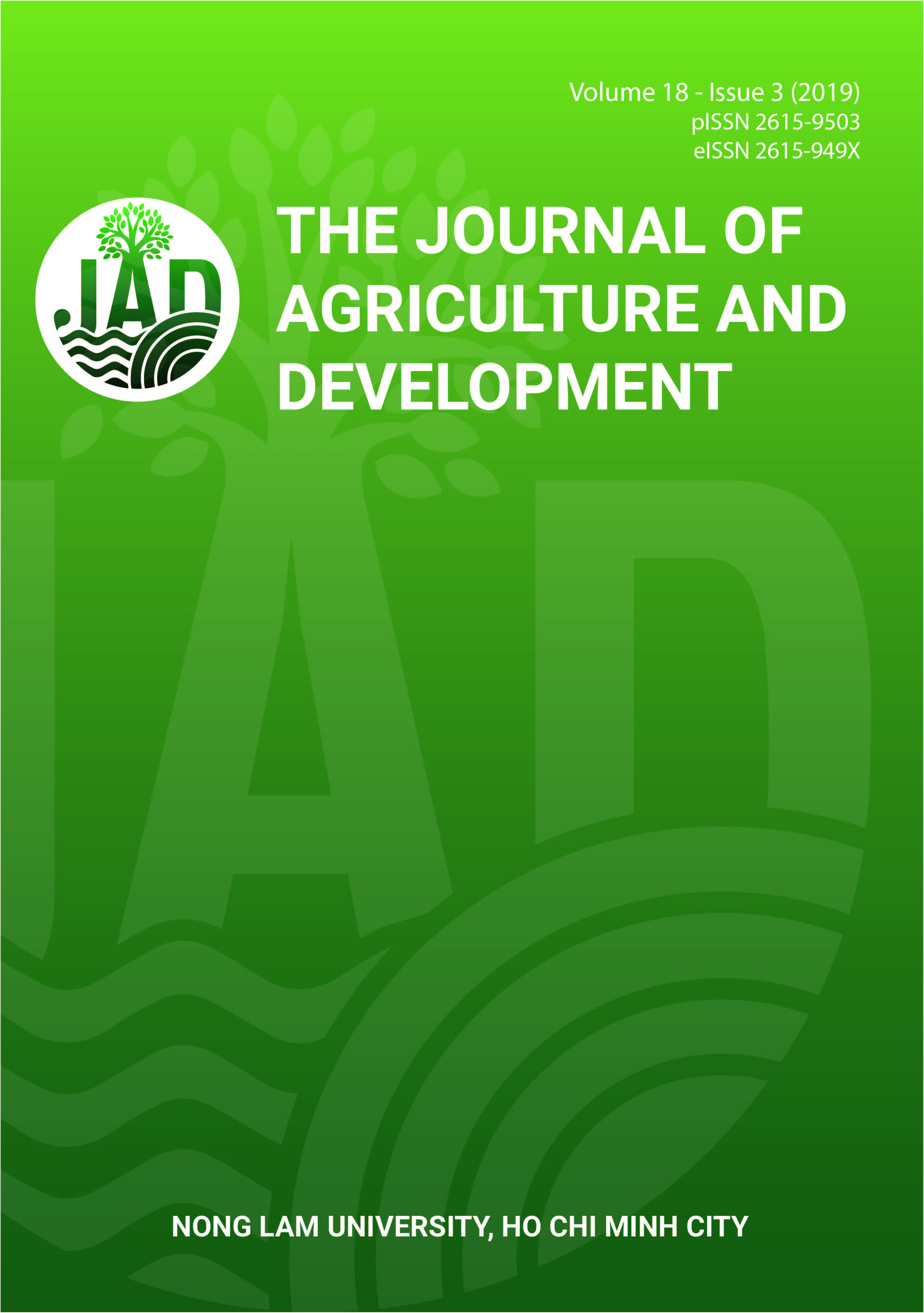Extraction and encapsulation of lesser galangal (Alpinia officinarum) essential oil using microwave pretreatment and spray drying
Main Article Content
Abstract
Galangal (Alpinia officinarum) essential oil potentially exerts several health benefits such as antiproliferative, pain relief and fever reduction activities. The essential oil in this study was extracted using the microwave (MW) assisted treatment as an alternative method to conventional extraction. The samples were treated with MW at different power levels (600, 700, and 800 W) for 3 min before subjecting to a hydro distillation extraction. The effect of sample:water ratio (1:1 and 1:0.5) was also investigated. The MW treatment at 600 W and sample:water ratio of 1:1 resulted in the highest amount of essential oil (0.33%). The MW pretreatment had a positive effect on reducing the extraction time (from 3 h to 2.5 h) observed at all MW power levels. The effect of essential oil loading capacity (10, 20 and 30%) on the encapsulation yield was evaluated. The in vitro antioxidative activity of the obtained powder was then measured. The highest encapsulation efficiency (86.5%) was obtained from the 20% loading capacity, suggesting for a suitable amount of essential oil should be loaded for the encapsulation. The in vitro antioxidant activity of the encapsulated essential oil powders was determined. The IC50 of the powder was 2077 μ g/mL using DPPH assay.
Article Details
References
Ahn, J. H., Kim, Y. P., Lee, Y.M., Seo, E. M., Lee, K. W., & Kim, H. S. (2008). Optimization of microencapsulation of seed oil by response surface methodology. Food Chemistry 107(1), 98-105. https://doi.org/10.1016/j.foodchem.2007.07.067
Bae, E. K., & Lee, S. J. (2008). Microencapsulation of avocado oil by spray drying using whey protein and maltodextrin. Journal of Microencapsulation 25(8), 549-560. https://doi.org/10.1080/02652040802075682
Behera, S., Nagarajan, S., & Rao, L. J. M. (2004). Microwave heating and conventional roasting of cumin seeds (Cuminum cyminum L.) and effect on chemical composition of volatiles. Food Chemistry 87(1), 25-29. https://doi.org/10.1016/j.foodchem.2003.10.012
Chudiwal, A. K., Jain, D. P., & Somani, R. S. (2010). Alpinia galanga Willd.–An overview on phyto-pharmacological properties. Indian Journal of Natural Products and Resources 1(2), 143-149.
Couto, R. O., Conceição, E. C., Chaul, L. T., Oliveira, E. M., Martins, F. S., Bara, M. T. F., Rezende, K. R., Alves, S. F., & Paula, J. R. (2012). Spray-dried rosemary extracts: physicochemical and antioxidant properties. Food Chemistry 131(1), 99-105. https://doi.org/10.1016/j.foodchem.2011.08.036
Danlami, J. M., Arsad, A., Zaini, M. A. A., & Sulaiman, H. (2014). A comparative study of various oil extraction techniques from plants. Reviews in Chemical Engineering 30(6), 605-626. https://doi.org/10.1515/revce-2013-0038
Fäldt, P., Bergenståhl, B. (1995). Fat encapsulation in spray-dried food powders. Journal of the American Oil Chemists’ Society 72(2), 171-176. https://doi.org/10.1007/BF02638895
Fernandes, R. V. d. B., Borges, S. V., & Botrel, D. A. (2013). Influence of spray drying operating conditions on microencapsulated rosemary essential oil properties. Food Science and Technology 33(Supl 1), 171-178.
Fernandes, R. V. d. B., Marques, G. R., Borges, S. V., & Botrel, D. A. (2014). Effect of solids content and oil load on the microencapsulation process of rosemary essential oil. Industrial Crops and Products 58, 173-181. https://doi.org/10.1016/j.indcrop.2014.04.025
Frascareli, E., Silva, V., Tonon, R., & Hubinger, M. (2012). Effect of process conditions on the microencapsulation of coffee oil by spray drying. Food and Bioproducts Processing 90(3), 413-424. https://doi.org/10.1016/j.fbp.2011.12.002
Jack, S. A., & Cooper, K. G. (2005). Microwave endometrial ablation: an overview. Reviews in Gynaecological Practice 5(1), 32-38. https://doi.org/10.1016/j.rigp.2004.06.005
Jimenez, M., Garcia, H. S., & Beristain, C. I. (2004). Spraydrying microencapsulation and oxidative stability of conjugated linoleic acid. European Food Research and Technology 219(6), 588-592. https://doi.org/10.1007/s00217-004-0992-4
Kausadikar, S., Gadhave, A. D., & Waghmare, J. (2015). Microencapsulation of lemon oil by spray drying and its application in flavour tea. Advanced Applied Science Research 6(4), 69-78.
Kha, T. C., Nguyen, M. H., Roach, P. D., & Stathopoulos, C. E. (2014). Microencapsulation of gac oil by spray drying: optimization of wall material concentration and oil load using response surface methodology. Drying Technology 32(4), 385-397. https://doi.org/10.1080/07373937.2013.829854
Khumpirapang, N., Pikulkaew, S., Anuchapreeda, S., & Okonogi, S. (2018). Alpinia galanga oil-A new natural source of fish anaesthetic. Aquaculture Research 49(4), 1546-1556. https://doi.org/10.1111/are.13609
Kittiphoom, S., & Sutasinee, S. (2015). Effect of microwaves pretreatments on extraction yield and quality of mango seed kernel oil. International Food Research Journal, 22(3), 960-964.
Manosroi, J., Dhumtanom, P., & Manosroi, A. (2006). Anti-proliferative activity of essential oil extracted from Thai medicinal plants on KB and P388 cell lines. Cancer Letters 235(1), 114-120. https://doi.org/10.1016/j.canlet.2005.04.021
Márquez‐Gómez, M., Galicia‐García, T., Márquez‐Meléndez, R., Ruiz‐Gutiérrez, M., & Quintero‐Ramos, A. (2018). Spray-dried microencapsulation of orange essential oil using modified rice starch as wall material. Journal of Food Processing and Preservation 42(2), e13428. https://doi.org/10.1111/jfpp.13428
McMillan, J. R., Watson, I. A., Ali, M., & Jaafar, W. (2013). Evaluation and comparison of algal cell disruption methods: microwave, waterbath, blender, ultrasonic and laser treatment. Applied Energy 103, 128-134. https://doi.org/10.1016/j.apenergy.2012.09.020
Proestos, C., & Komaitis, M. (2008). Application of microwave-assisted extraction to the fast extraction of plant phenolic compounds. LWT-Food Science and Technology 41(4), 652-659. https://doi.org/10.1016/j.lwt.2007.04.013
Saénz, C., Tapia, S., Chávez, J., & Robert, P. (2009). Microencapsulation by spray drying of bioactive compounds from cactus pear (Opuntia ficus-indica). Food Chemistry 114(2), 616-622. https://doi.org/10.1016/j.foodchem.2008.09.095
Sahoo, S., Parida, R., Singh, S., Padhy, R. N., & Nayak, S. (2014). Evaluation of yield, quality and antioxidant activity of essential oil of in vitro propagated Kaempferia galanga Linn. Journal of Acute Disease 3(2), 124-130. https://doi.org/10.1016/S2221-6189(14)60028-7
Tomazelli, J. O., Kuhn, F., Padilha, P. J. M., Vicente, L. R., Costa, S. W., Boligon, A. A., Scapinello, J., Nesi, C. N., Magro, D. J., & Castellví, S. L. (2018). Microencapsulation of essential thyme oil by spray drying and its antimicrobial evaluation against Vibrio alginolyticus and Vibrio parahaemolyticus. Brazilian Journal of Biology 78(2), 311-317. https://doi.org/10.1590/1519-6984.08716
Tongnuanchan, P., & Benjakul, S. (2014). Essential oils: extraction, bioactivities, and their uses for food preservation. Journal of Food Science 79(7), R1231-R1249. https://doi.org/10.1111/1750-3841.12492








